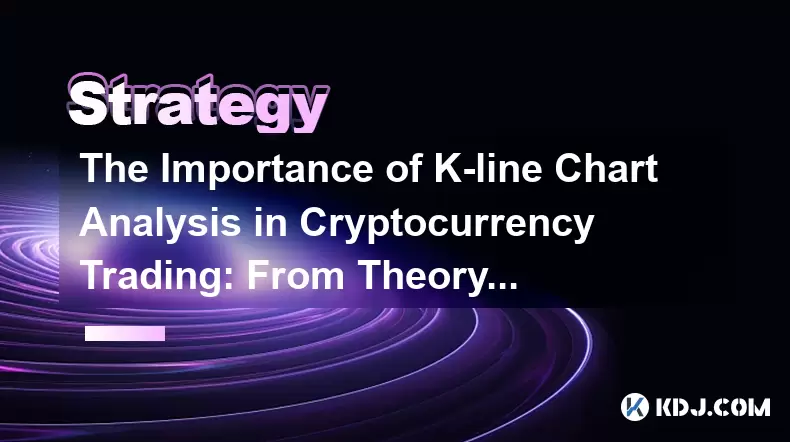-
 bitcoin
bitcoin $112195.049338 USD
2.42% -
 ethereum
ethereum $4124.915858 USD
2.81% -
 tether
tether $1.000570 USD
0.02% -
 xrp
xrp $2.861568 USD
2.25% -
 bnb
bnb $1000.346670 USD
3.04% -
 solana
solana $209.070819 USD
3.38% -
 usd-coin
usd-coin $0.999870 USD
0.02% -
 dogecoin
dogecoin $0.235379 USD
2.65% -
 tron
tron $0.335681 USD
-0.20% -
 cardano
cardano $0.803501 USD
3.38% -
 hyperliquid
hyperliquid $47.120881 USD
3.56% -
 chainlink
chainlink $21.501300 USD
3.44% -
 ethena-usde
ethena-usde $1.000571 USD
0.02% -
 avalanche
avalanche $29.793378 USD
3.62% -
 stellar
stellar $0.366964 USD
2.42%
The Importance of K-line Chart Analysis in Cryptocurrency Trading: From Theory to Practical Cases
K-line charts, or candlestick charts, visually represent price movements in cryptocurrency trading, helping traders analyze market sentiment and predict potential reversals through patterns like hammers, engulfing candles, and dojis.
Jun 11, 2025 at 04:56 pm

Understanding the Basics of K-line Charts
K-line charts, also known as candlestick charts, are a visual representation of price movements over specific time intervals. Each K-line encapsulates four critical data points: the opening price, closing price, highest price, and lowest price within a given timeframe. These charts originated in Japan during the 18th century to track rice prices and have since become a cornerstone of technical analysis across financial markets, including cryptocurrency trading.
In cryptocurrency markets, where volatility is a defining characteristic, K-line chart analysis allows traders to interpret market sentiment and anticipate potential price reversals or continuations. The ability to read these patterns gives traders an edge in making informed decisions rather than relying on intuition or speculation.
Each candlestick has a body and wicks (or shadows). The body represents the range between the opening and closing prices, while the wicks show the high and low extremes. When the closing price is higher than the opening price, the candlestick is typically colored green or hollow; otherwise, it's red or filled.
Key Components of K-line Patterns
To effectively use K-line chart analysis, traders must understand common candlestick patterns and what they signify. Here are some widely recognized formations:
- Bullish Engulfing Pattern: This occurs when a small bearish candle is followed by a larger bullish candle that completely 'engulfs' the previous candle. It often signals a potential reversal from a downtrend.
- Bearish Engulfing Pattern: The opposite of the bullish engulfing pattern, this indicates a possible shift from an uptrend to a downtrend.
- Hammer and Hanging Man: Both have small bodies with long lower wicks. A hammer appears at the bottom of a downtrend and suggests buying pressure, while a hanging man appears at the top of an uptrend and may indicate selling pressure.
- Shooting Star and Inverted Hammer: These are similar in appearance but differ in context. A shooting star forms after an uptrend and hints at a potential reversal, whereas an inverted hammer appears during a downtrend and may signal a bullish reversal.
Recognizing these patterns helps traders make better-informed decisions about entry and exit points in the market.
Applying K-line Analysis in Real-Time Trading Scenarios
Let’s walk through a practical example using Bitcoin (BTC) on a daily chart. Suppose BTC has been in a downtrend for several days, and suddenly a hammer candlestick forms. This candle has a small body near the top of its range and a long lower wick, indicating that sellers pushed the price down significantly but buyers managed to bring it back up by the close.
A trader analyzing this situation might interpret the hammer as a sign of rejection at that support level. If the next day's candle closes above the hammer's high, it could confirm a reversal. At that point, the trader might consider entering a long position with a stop-loss below the hammer’s low.
Another case involves Ethereum (ETH) showing a bullish engulfing pattern after a period of consolidation. The engulfing candle completely covers the prior bearish candle, suggesting strong buying pressure. Traders may see this as a signal to enter a buy trade, placing a stop-loss just beneath the engulfing candle’s low.
These examples illustrate how real-time K-line chart analysis can guide trading strategies based on historical price behavior.
Combining K-line Patterns with Other Technical Indicators
While K-line charts provide valuable insights, they should not be used in isolation. Combining them with other technical indicators enhances accuracy and reduces false signals. Popular tools include:
- Moving Averages (MA): Help identify trends and filter out noise. For instance, if a bullish engulfing candle forms near a key moving average like the 50-day MA, it strengthens the validity of the signal.
- Relative Strength Index (RSI): Measures overbought or oversold conditions. A hammer candle forming when RSI is below 30 increases the likelihood of a bullish reversal.
- Volume: Confirms the strength behind a candlestick pattern. An increase in volume during a bullish engulfing formation supports the idea of strong buying interest.
Using these tools together creates a more robust framework for K-line chart interpretation, enabling traders to filter out weak signals and focus on high-probability setups.
Common Mistakes in K-line Chart Interpretation
Even experienced traders can misinterpret K-line patterns due to several common pitfalls:
- Ignoring Timeframes: A bullish pattern on a 1-hour chart may not carry the same weight as one on a daily chart. Traders must align their analysis with their trading strategy's timeframe.
- Overreliance on Single Candles: No single candlestick guarantees a reversal or continuation. Always look for confirmation from subsequent candles or supporting indicators.
- Neglecting Market Context: A doji candle in a ranging market means something different than in a trending environment. Understanding the broader market structure is crucial.
- Failing to Use Stop-Losses: Even the most reliable K-line pattern can fail. Proper risk management, such as setting stop-loss orders, protects capital from unexpected moves.
Avoiding these mistakes ensures that K-line chart analysis remains a useful tool rather than a source of confusion or loss.
Frequently Asked Questions (FAQs)
Q1: Can K-line charts be used for all cryptocurrencies?Yes, K-line charts are universally applicable across all cryptocurrencies. Whether you're analyzing Bitcoin, Ethereum, or lesser-known altcoins, the principles remain the same. However, liquidity and volume can affect the reliability of patterns in smaller-cap tokens.
Q2: Is K-line chart analysis suitable for beginners?Absolutely. While mastering K-line chart interpretation takes practice, beginners can start with basic patterns like doji, hammers, and engulfing candles. Many online platforms offer educational resources to help new traders learn how to read these charts effectively.
Q3: How accurate are K-line patterns in predicting price movements?No analytical method is 100% accurate, and K-line chart patterns are no exception. Their effectiveness depends on market conditions, timeframe, and whether they're supported by other indicators. Used wisely, they can significantly improve the probability of successful trades.
Q4: Should I rely solely on K-line charts for trading decisions?It's generally not advisable to rely exclusively on K-line chart analysis. Incorporating other tools like volume, trendlines, and technical indicators provides a more comprehensive view and reduces the risk of false signals.
Disclaimer:info@kdj.com
The information provided is not trading advice. kdj.com does not assume any responsibility for any investments made based on the information provided in this article. Cryptocurrencies are highly volatile and it is highly recommended that you invest with caution after thorough research!
If you believe that the content used on this website infringes your copyright, please contact us immediately (info@kdj.com) and we will delete it promptly.
- Solana at $197: Hunting for High-ROI Tokens in the Crypto Jungle
- 2025-09-30 03:05:17
- Mike Novogratz's XRP U-Turn: From Underestimated to Undeniable
- 2025-09-30 03:05:17
- SANDchain, Token Launchpads, and the Sandbox: Riding the Web3 Wave
- 2025-09-30 03:18:35
- Axl Rose's Graphic Novel: Can He Save Humanity From Paradise City?
- 2025-09-30 02:45:11
- Predictive Oncology's Bold Leap: AI, Digital Assets, and a Treasury Strategy Revolution
- 2025-09-30 03:18:35
- Axl Rose's 'Appetite for Destruction' Gets a Graphic Novel Makeover!
- 2025-09-30 02:45:11
Related knowledge

Practical parameter settings for a Bitcoin multi-timeframe moving average system
Sep 18,2025 at 10:54pm
Optimizing Timeframe Combinations for Bitcoin Trading1. Selecting appropriate timeframes is crucial when building a multi-timeframe moving average sys...

How can I filter out false breakouts in Dogecoin high-frequency trading?
Sep 22,2025 at 01:00am
Understanding False Breakouts in Dogecoin Trading1. A false breakout occurs when Dogecoin's price appears to move beyond a defined support or resistan...

Techniques for identifying tops and bottoms in the Bitcoin on-chain NVT model
Sep 20,2025 at 07:54pm
Understanding the NVT Model in Bitcoin Analysis1. The Network Value to Transactions (NVT) ratio is often described as the 'P/E ratio' of the cryptocur...

What does the surge in open interest in Bitcoincoin futures mean?
Sep 20,2025 at 11:18pm
Understanding the Surge in Dogecoin Futures Open Interest1. A surge in open interest within Dogecoin futures indicates a growing number of active cont...

How can I use the Ethereum USDT premium to gauge market sentiment?
Sep 18,2025 at 11:55pm
Understanding the Ethereum USDT Premium1. The Ethereum USDT premium refers to the price difference between USDT (Tether) traded on Ethereum-based plat...

What should I do if Ethereum staking yields decline?
Sep 20,2025 at 06:18am
Understanding the Causes Behind Declining Ethereum Staking Yields1. The Ethereum network transitioned to a proof-of-stake consensus mechanism with the...

Practical parameter settings for a Bitcoin multi-timeframe moving average system
Sep 18,2025 at 10:54pm
Optimizing Timeframe Combinations for Bitcoin Trading1. Selecting appropriate timeframes is crucial when building a multi-timeframe moving average sys...

How can I filter out false breakouts in Dogecoin high-frequency trading?
Sep 22,2025 at 01:00am
Understanding False Breakouts in Dogecoin Trading1. A false breakout occurs when Dogecoin's price appears to move beyond a defined support or resistan...

Techniques for identifying tops and bottoms in the Bitcoin on-chain NVT model
Sep 20,2025 at 07:54pm
Understanding the NVT Model in Bitcoin Analysis1. The Network Value to Transactions (NVT) ratio is often described as the 'P/E ratio' of the cryptocur...

What does the surge in open interest in Bitcoincoin futures mean?
Sep 20,2025 at 11:18pm
Understanding the Surge in Dogecoin Futures Open Interest1. A surge in open interest within Dogecoin futures indicates a growing number of active cont...

How can I use the Ethereum USDT premium to gauge market sentiment?
Sep 18,2025 at 11:55pm
Understanding the Ethereum USDT Premium1. The Ethereum USDT premium refers to the price difference between USDT (Tether) traded on Ethereum-based plat...

What should I do if Ethereum staking yields decline?
Sep 20,2025 at 06:18am
Understanding the Causes Behind Declining Ethereum Staking Yields1. The Ethereum network transitioned to a proof-of-stake consensus mechanism with the...
See all articles


























![[Pycoin] PI Coin -Shocking Listance of Pycoin?! 'Rebellion' This time ... Pay attention to #paikoin [Pycoin] PI Coin -Shocking Listance of Pycoin?! 'Rebellion' This time ... Pay attention to #paikoin](/uploads/2025/09/29/cryptocurrencies-news/videos/pycoin-pi-coin-shocking-listance-pycoin-rebellion-time-pay-attention-paikoin/68da82f23cec1_image_500_375.webp)















































